Red telephone box
The red telephone box, a telephone kiosk for a public telephone designed by Sir Giles Gilbert Scott, is a familiar sight on the streets of the United Kingdom, Malta, Bermuda and Gibraltar.

Despite a reduction in their numbers in recent years, the traditional British red telephone kiosk can still be seen in many places throughout the UK, and in current or former British colonies around the world. The colour red was chosen to make them easy to spot.
From 1926 onwards, the fascias of the kiosks were emblazoned with a prominent crown, representing the British government. The red phone box is often seen as a British cultural icon throughout the world.[1] In 2006 the K2 telephone box was voted one of Britain's top 10 design icons, which included the Mini, Supermarine Spitfire, London tube map, World Wide Web, Concorde and the AEC Routemaster bus.[2][3] Although production of the traditional boxes ended with the advent of the KX series in 1985, many still stand in Britain.
Design history
K1
The first standard public telephone kiosk introduced by the United Kingdom Post Office was produced in concrete in 1921 and was designated K1 (Kiosk No.1). This design was not of the same family as the familiar red telephone boxes. As of 2020, there are seven K1 boxes in existence, all of which have been listed at Grade II by Historic England, with two still located on British streets.[4] The first is situated in Trinity Market in Kingston-upon-Hull,[5] and the other in Bembridge High Street, Isle of Wight.[6]
K2

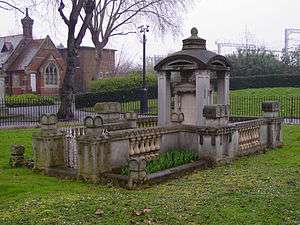
The red telephone box was the result of a competition in 1924 to design a kiosk that would be acceptable to the London Metropolitan Boroughs which had hitherto resisted the Post Office's effort to erect K1 kiosks on their streets.
The Royal Fine Art Commission was instrumental in the choice of the British standard kiosk. Because of widespread dissatisfaction with the GPO's design, the Metropolitan Boroughs Joint Standing Committee organised a competition for a superior one in 1923, but the results were disappointing. The Birmingham Civic Society then produced a design of its own—in reinforced concrete—but it was informed by the Director of Telephones that the design produced by the Office of the Engineer-in-Chief was preferred; as the Architects' Journal commented, "no one with any knowledge of design could feel anything but indignation with the pattern that seems to satisfy the official mind". The Birmingham Civic Society did not give up and, with additional pressure from the Royal Institute of British Architects, the Town Planning Institute and the Royal Academy, the Postmaster General was forced to think again; and the result was that the RFAC organised a limited competition.
The organisers invited entries from three respected architects and, along with the designs from the Post Office and from The Birmingham Civic Society, the Fine Arts Commission judged the competition and selected the design submitted by Sir Giles Gilbert Scott.[7] The invitation had come at the time when Scott had been made a trustee of Sir John Soane's Museum: his design for the competition was in the classical style, but topped with a dome reminiscent of Soane's self-designed mausoleums in St Pancras' Old Churchyard and Dulwich Picture Gallery, London.[8]
The original wooden prototypes of the entries were later put into public service at under-cover sites around London. That of Scott's design is the only one known to survive and is still where it was originally placed, in the left entrance arch to the Royal Academy.
The Post Office chose to make Scott's winning design in cast iron (Scott had suggested mild steel) and to paint it red (Scott had suggested silver, with a "greeny-blue" interior) and, with other minor changes of detail, it was brought into service as the Kiosk No.2 or K2. From 1926 K2 was deployed in and around London and the K1 continued to be erected elsewhere.
K3
K3, introduced in 1929, again by Giles Gilbert Scott, was similar to K2 but was constructed from concrete and intended for nationwide use. Cheaper than the K2, it was still significantly more costly than the K1 and so that remained the choice for low-revenue sites. The standard colour scheme for both the K1 and the K3 was cream, with red glazing bars. A rare surviving K3 kiosk can be seen beside the Penguin Beach exhibit at ZSL London Zoo, where it has been protected from the weather by the projecting eaves and recently restored to its original colour scheme. There is another in use at Rhynd in Perthshire.
K4
K4 (designed by the Post Office Engineering Department in 1927) incorporated a post box and machines for buying postage stamps on the exterior. Only a single batch of 50 K4 kiosks were built. Some contemporary reports said the noise of the stamp-machines in operation disturbed phone-users, and the rolls of stamps in the machines became damp and stuck together in wet weather. This has been widely repeated (including by Stamp[9]) but Johannessen[10] chose not to, having found no evidence to support the story. Ten survive with four in public use at Frodsham, Warrington, Whitley Bay and near Tunstall, East Riding of Yorkshire. A fine example of a K4 may also be found outside the station building at Bewdley on the Severn Valley Railway.
K5
K5 was a metal-faced plywood construction introduced in 1934 and designed to be assembled and dismantled and used at exhibitions. It is not known how many were produced, and there is little evidence they ever reached more than prototype stage. A fully detailed replica (constructed using the original drawings) can be seen at The Avoncroft Museum (Bromsgrove, Worcestershire), as part of the National Telephone Kiosk Collection.

K6
In 1935 the K6 (kiosk number six) was designed to commemorate the silver jubilee of King George V. It was consequently sometimes known as the "Jubilee" kiosk. It went into production in 1936.[11] The K6 was the first red telephone kiosk to be extensively used outside London, and many thousands were deployed in virtually every town and city, replacing most of the existing kiosks and establishing thousands of new sites. In 1935 there had been 19,000 public telephones in the UK: by 1940, thanks to the K6, there were 35,000.[12]
The design was again by Scott, and was essentially a smaller and more streamlined version of the K2, intended to be produced at a considerably cheaper cost, and to occupy less pavement space. The principal differences between the two designs were:
- Size. The K6 was 8 feet 3 inches (2.51 m) tall and weighed 13.5 cwt (0.69 tonnes). This compared with 9 feet 3 inches (2.82 m) and 1.25 tons (1.27 tonnes) for the K2.
- Elements of the design were simplified and streamlined, in keeping with the "moderne" aesthetics of the 1930s. The Grecian fluting was removed from the door and window surrounds, and the previously separate pediment and frieze were merged.
- The Crown motif (see below), which had previously been pierced through the ironwork to give ventilation, was now embossed in bas-relief. A new, separate ventilation slot was provided.
- A new glazing pattern was introduced. The door and two glazed sides of the K2 each had 18 equal-sized panes of glass arranged in 6 rows of 3. In the K6 the number of rows was increased to 8, and the central column of panes was made considerably wider than those to either side. This improved visibility, and gave a more horizontal appearance to the windows, again in keeping with "moderne" principles.[13]
The K6 has since become a British icon, but it was not universally loved at the start. The red colour caused particular local difficulties and there were many requests for less visible colours. The Post Office was forced into allowing a less strident grey with red glazing bars scheme for areas of natural and architectural beauty. Ironically, some of these areas that have preserved their telephone boxes have now painted them red. The paint colour used most widely today is known as "currant red" and is defined by a British Standard, BS381C-Red539.[14] This slightly brighter red was introduced with the K8 model in 1968, but went on to be used across the estate on previous models too. Hence, for complete historical accuracy, any kiosks in pre-1968 settings should really be painted in the previous, and slightly darker, shade BS381C-Red538.
Kiosk installation: the early years
With continued demand for K6 kiosks, siting them was more widespread than ever before. A purpose built kiosk trailer was designed from 1953 to reduce the running costs of cranes.[15]
Numbers installed
The K6 was the most prolific kiosk in the UK and its growth, from 1935, can be seen from the BT archives:
| Period | Number | Notes |
|---|---|---|
| 1925– | 1,000 | (K1 Only) |
| 1930– | 8,000 | (K2 & K3 added) |
| 1935– | 19,000 | (K6 introduced) |
| 1940– | 35,000 | |
| 1950– | 44,000 | |
| 1960– | 64,000 | |
| 1970– | 70,000 | (K8 introduced in 1968) |
| 1980– | 73,000 |
Fabrication
The K1 and the later K3 concrete kiosks were produced at various (and largely unrecorded) locations, around the country. This made quality control and supervision of the manufacturing process difficult, when compared to the GPO's experience with cast-iron post boxes, and was an important aspect of the GPO's move towards cast-iron telephone kiosks. Over the years, five foundries were involved in this work for the Post Office. Lion Foundry in Kirkintilloch, MacFarlane (Saracen Foundry), and Carron Ironworks near Falkirk all produced batches of the K2, the K6 and the K8; and, in addition, Carron produced the single batch of K4 kiosks. The other two manufacturers were McDowall Steven and Bratt Colbran, both of which produced only relatively small batches of the pre-war Mk1 K6.
Although many kiosks have been fitted with replacement backs over recent years, unmodified examples generally have the identity of their manufacturer marked on a plate on the outside at the bottom of their back panel. The only exceptions are the few Mk1 models made by Bratt Colbran, which are anonymous. A supplementary way of identifying the manufacturer is by means of casting marks on the various component parts – i.e. LF, CC, MF, MS and BC – which were used to various extents over the years. A more consistent manufacturer mark can be found at about shoulder height on the inner face of the back panel. These marks generally identify both the manufacturer and the precise model of kiosk. Up to around 1949, the year of manufacture is also included. The more recently erected non-BT K6 kiosks (generally painted black) are for the most part new castings, sourced from new manufacturers.
Crown

_converted_to_Defibrillator.jpg)
From 1926 onwards, the fascias of Post Office kiosks were emblazoned with a prominent crown, representing the British government (of which the Post Office was an agency). The design was initially the "Tudor Crown", then in widespread use in government service. The same crown was used in all parts of the United Kingdom and British Empire. On the K2, the design was pierced through the ironwork, and acted as a ventilation hole. On the K6, a separate ventilation slot was provided, and the crown was embossed in bas-relief.
In 1953 the new Queen, Elizabeth II, decided to replace the Tudor Crown in all contexts with a representation of the actual crown generally used for British coronations, the St Edward's Crown. This new symbol therefore began to appear on the fascias of K6 kiosks.
St Edward's Crown was initially used on kiosks in all parts of the United Kingdom. However, in Scotland, following protests over the use of English insignia, the Post Office (like other government agencies there) began to use, from 1955, a representation of the actual Crown of Scotland. To accommodate the two different designs of crown on K6 kiosks, the fascia sections were henceforth cast with a slot in them, into which a plate bearing the appropriate crown was inserted before the roof section was fitted.
The crowns were originally painted the same red as the rest of the box. However, since the early 1990s, when the heritage value of red kiosks began to be widely recognised, British Telecom has picked out the crowns (on both K2s and K6s) in gold paint.
Kiosks installed in Kingston upon Hull were not fitted with a crown, as those kiosks were installed by the Hull Corporation (later Hull City Council, then Kingston Communications). All boxes in Hull were also painted in cream.
Modernisation – K7 & K8

In 1959 architect Neville Conder was commissioned to design a new box. The K7 design went no further than the prototype stage. K8 was introduced in 1968 designed by Bruce Martin. It was used primarily for new sites; around 11000 were installed, replacing earlier models only when they needed relocating or had been damaged beyond repair. The K8 retained a red colour scheme, but it was a different shade of red: a slightly brighter "Poppy Red", which went on to be the standard colour across all kiosks.
The K8 featured a single large glass panel on two sides and the door. While improving visibility and illumination inside the box, these were vulnerable to damage. There were two versions – the Mk1 and the Mk2 – with the most visible difference being in the detail of the roof and the surround of the 'TELEPHONE' opals.
With regards to create a new box with easier access, lower maintenance and brighter lighting, the Post Office introduced a prototype run of "Croydon" telephone boxes from 1972, named as such because they were erected in Croydon.[16] The Croydon boxes, which featured a black handset silhouette with bright yellow paintwork, were erected as an experimental prototype to replace the red telephone boxes. However, whilst the trials were successful, the quality of the materials and design made it too expensive for the Post Office to mass-produce and the design was not adopted.[17]
In either the late 1970s or late 1980s, a new, smaller hooded booth was introduced known as Booth 7A.[18] These yellow booths were introduced into areas where previous red telephone boxes had been vandalised or even pulled out of the ground. They became known as "Oakham" boxes – a reference to the similarity in shape with an Oak Ham tin.
Privatisation and the KX series
In 1980, in preparation for privatisation, Post Office Telephones was rebranded as British Telecom (BT). In February 1981, it was announced that all the red telephone boxes would be repainted yellow, which was BT's new corporate colour. There was an immediate public outcry; the Daily Mail launched a campaign "against the yellow peril"[19] and questions were asked in Parliament. In the House of Lords, the Earl of Gowrie, the Minister of State for Employment, called on BT "to abandon this ridiculous scheme".[20] In the House of Commons, Mark Lennox-Boyd MP asked the Prime Minister, Margaret Thatcher, if she would treat the decision "with the greatest possible dismay". Thatcher, who was responsible for the privatisation, would only say that she could "see my honourable Friend's point".[21] Shortly afterwards, BT announced that only 90 of the 77,000 remaining traditional boxes had been painted different colours "as an experiment" and that no final decision had been reached.[19]
After privatisation in 1982, British Telecom introduced the KX100, a more utilitarian design, which began to replace most of the existing boxes. The KX100 was one of a series of designs, including the wheelchair-accessible open-sided KX200, and the triangular-footprint KX300.[22] In January 1985, Nick Kane, the Director of Marketing for BT Local Communications Services announced that the old red telephone boxes would be replaced because they "...no longer meet the needs of our customers. Few people like to use them. They are expensive and difficult to clean and maintain and cannot be used by handicapped people".[23] This time, BT did not relent, despite another vociferous campaign.
Many local authorities used legislation designed to protect buildings of architectural or historic importance to keep old telephone boxes in prominent locations and around 2,000 of them were given listed status. Several thousand others were left on low-revenue mostly rural sites but many thousands of recovered K2 and K6 boxes were sold off. Some kiosks have been converted to be used as shower cubicles in private homes. In Kingston upon Thames a number of old K6 boxes have been used to form a work of art resembling a row of fallen dominoes.[24] As of January 2020, it was estimated that 8,000 traditional red telephone boxes remain in public service.[25] The KX+, better known as the KX100 PLUS, introduced in 1996 featured a domed roof reminiscent of the familiar K2 and K6. Subsequent designs have departed significantly from the old style red boxes. BT followed the KX series with the Multi.phone in 1999 and the ST6 in 2007.
InLinkUK
BT is one of the partners in InLinkUK, a new communications service intended to replace over 1,000 payphones in major UK cities. The InLink unit provides free public Wi-Fi, phone calls and device charging.[26]
Adoption
Little-used red telephone boxes can be adopted[27] by parish councils in England for other uses. Some examples are shown below. The kiosk may be used for any legal purpose other than telephony and the contract of sale[28] includes the following clause 5.5.4:
The buyer shall covenant not to sell, lease or license the Goods to a competitor to the Seller nor to permit a competitor to install electronic communications apparatus (as defined in schedule 2 of the Telecommunications Act 1984) within the Goods or itself (as the Buyer) shall not install, provide or operate any form of electronic communications apparatus (as defined in schedule 2 of the Telecommunications Act 1984) within the Goods.
It is unclear why BT wishes to prohibit the kiosk from being re-used for electronic communications and why the regulator, Ofcom, has allowed it. In the US, there is an active movement seeking new telecom uses for little-used telephone booths, for example as wi-fi hotspots.[29]
Libraries
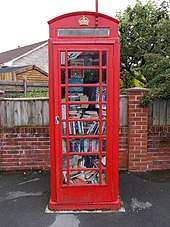
During 2009 a K6 in the village of Westbury-sub-Mendip in Somerset was converted into a library or book exchange replacing the services of the mobile library which no longer visits the village.[30][31][32] Similar libraries now exist in the villages of North Cadbury in Somerset, Great Budworth in Cheshire,[33]Little Shelford and Upwood in Cambridgeshire and some 150 other locations.[34] One such box was donated by Cumbernauld's town twinning association and installed as a library in Bron, France.[35] there is also The Telephone Box Book Exchange in Cutnall Green opened in June 2016
Art gallery
Also in 2009, the town of Settle in North Yorkshire established the Gallery on the Green in a K6, which had been adopted by the Parish Council. The Gallery has featured a range of exhibitions (see the online gallery on the website) of both notable artists and photographers (Tessa Bunney, Martin Parr, Mariana Cook) and local community groups. Its most famous contributor was Brian May, with his stereoscopic photography show 'A Village Lost and Found'.
Defibrillator

Following a competition by a Girl Guide unit in 2011 to find a use for their local disused telephone box in Glendaruel, Argyll, it has been fitted with a defibrillator. The equipment can only be accessed by following instructions from the Scottish Ambulance Service during an emergency call. The conversion of the box was paid for by BT under the Adopt A Kiosk scheme and the defibrillator was supplied by the Community Heartbeat Trust. Similar installations have been made at Loweswater, Cumbria,[36][37], Auchenblae, Aberdeenshire, Withernwick, East Riding of Yorkshire and Witney, Oxfordshire.[38]
Other
In 2010, in the village of Brookwood, Surrey, a project was initiated to restore and preserve the sole remaining K6 kiosk in the village. The kiosk had been adopted by Woking Borough Council in 2009 and a group of residents set about restoring the kiosk. This was achieved through private donations and sponsorship from local businesses.[39] A blog detailed the restoration.[40]
As of 2012, remanufactured units were offered for sale by X2Connect.[41][42][43]
From October 2014, several of London's disused K6 telephone boxes have been painted green and converted to free mobile phone chargers named Solarboxes.[44] They have been considered an outdoor kiosk alternative to indoor chargers such as the Chargebox.
Usage elsewhere

Several of these distinctive telephone boxes have been installed on the Norman, Oklahoma, campus of the University of Oklahoma, where they continue to serve their originally intended function. Elsewhere in the United States, a few have also been installed in downtown Glenview, Illinois, and Glencoe, Illinois. There is also one outside the British Embassy in Washington, D.C. A red telephone box can also be found on the Courthouse Square in Oxford, Mississippi. There are two in use in Tennessee. One is located on the square in Collierville, Tennessee, and the other is located next to Pepper Palace in The Village Shops shopping center in Gatlinburg, Tennessee.[45]
In Massachusetts, there is also a red telephone box in the student centre of the Massachusetts Institute of Technology. In addition, there is a red telephone box outside the town building (town hall/police station/post office) in the tiny mountain town of Rowe, Massachusetts, which is an original installation dating back to when the town of Rowe first got telephone service. Two red telephone boxes are on display at the World Showcase area of Disney's Epcot in Orlando, Florida, one located in the United Kingdom area and one in the Canada area. One is on display at English Gardens a Place for Weddings in Winter Park close to downtown Orlando. An original K6 can also be found outside of the Allied Building in Treasure Island, Florida. There are also a few red boxes at the Ellenton Outlet Mall, just off I-75, near Bradenton, Florida. These still have their original STD code cards in place and have working US payphone equipment. There is a red telephone box in Westminster Maryland on the corner of West Main Street and Rt. 27 outside of Johanson's Dining House.[46]

Australia and New Zealand each had their own design of red telephone box, and some examples have been preserved in sensitive or historic sites. A brief and colourful campaign was run to "save" the red telephone box in New Zealand by the Wizard of New Zealand.[47]
Red phone boxes can be seen in Portugal – for example, they are a common sight in the city of Porto.[48]
In Lake Havasu City, Arizona, a few K6s arrived when the old London Bridge was preserved there. As they are in the US, and not under British restriction, they are fully functional, but with updated electronics to make them code compliant.
British K6 phone boxes are to be found, painted green, in the centre of Kinsale, an old historic town in County Cork within the Republic of Ireland.
Red telephone boxes are also found across Malta, Gozo, some islands of the West Indies such as Antigua, Barbados, as well as in Cyprus, showing that the colonial influence is still present. Some of those telephone booths are being used as internet kiosks.
A box can also be found in the centre of the town of Chinon, France[49] and another in the German town of Bad Münstereifel.
Thames Town, an imitation English town on the outskirts of Shanghai, includes red telephone boxes.[50]
In 2008, ten K6 telephone boxes were imported from the United Kingdom to the Israeli city of Petah Tikva and installed on its main street, Haim Ozer.
Kingston upon Hull
Kingston upon Hull ran a municipal telephone system from 1904. There were a number of such municipal services in the UK, but whereas most had been brought under the Post Office monopoly by 1913, Hull's, uniquely, remained under the control of Hull Corporation (the city council). As a result, although the Corporation used K6 kiosks, these were painted cream, and had the crown omitted from the design. The Hull telephone system was privatised in 1999, and was taken over by Kingston Communications (KC; later renamed KCOM Group in 2007). In about 2007, KC removed many of the cream K6 boxes. After public complaints at the loss of heritage, it was agreed that approximately 125 of the boxes would be retained, and these remain in use. KC also allocated limited numbers (approximately 1,000) to be sold to the general public, many of which were sold off even before they had been removed from service. Hull also continues to use K8 and KX 100 PLUS kiosks, and in the past has used other non-GPO/BT designs.
Crown Dependencies
The telephone services of the Crown Dependencies were split at various times from the GPO.
Guernsey
Guernsey Telecoms painted its kiosks yellow with white window frames; they were repainted in blue when the company was sold to Cable and Wireless in 2002.
Jersey
Jersey Telecom used locally made kiosks, painted in cream and yellow or just yellow.
Isle of Man
Manx Telecom has left its kiosks in the red colour used by its predecessors British Telecom and the GPO. A green telephone box exists in Cregneash, as was the practice in many rural areas of Britain.
Overseas territories
Akrotiri and Dhekelia
At least one is present in Dhekelia.
Gibraltar
Gibtelecom operate red kiosks of various vintages.
Use in contemporary art
Out of Order
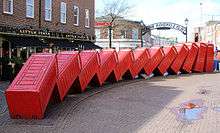
Scottish sculptor David Mach created the permanent public work Out of Order in 1989 in Kingston upon Thames, London. It takes the form of a row of twelve K6 telephone boxes, the first one upright, the others gradually falling over like dominoes. It was originally intended that the last upright box was to contain a working telephone.
BT Artboxes

In 2012, BT helped celebrate the 25th anniversary of the free-phone charity ChildLine by commissioning eighty artists to design and decorate full-sized K6 replicas. These were displayed in public spaces across London and then auctioned by Sotheby's as BT Artboxes. Artists included Peter Blake, Willie Christie, David Mach, Denis Masi, Zaha Hadid and Ian Ritchie.
Pop culture
The red telephone box has appeared in British pop culture, such as in Adele's video "Hello", the front cover of One Direction's album Take Me Home, the back cover of David Bowie's album The Rise and Fall of Ziggy Stardust and the Spiders from Mars, and features in a prominent scene in the 1955 black comedy film The Ladykillers where a motley gang of crooks led by Professor Marcus (Alec Guinness) cram into one.[51][52]
In 2016, British chef Gordon Ramsay opened a British-themed fish restaurant in the Las Vegas Strip, with the doors to the entrance resembling the red telephone box.[53]
The progressive rock band Lifesigns' debut 2013 album Lifesigns[54] features a red telephone box which was added to the village scene on the album cover to signify the song Telephone. The band continued the theme on the cover of their live DVD/CD Live in London Under the Bridge[55] by featuring a row of white telephone boxes modelled on the cream telephone boxes in Kingston upon Hull where two of the band are from.
Image gallery
- GPO/BT telephone kiosks
- K1 Telephone Box, Lowestoft Transport Museum
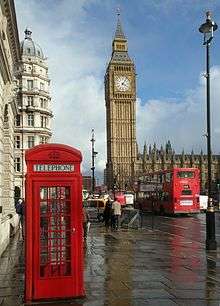 K2 with a London double-decker bus and Big Ben in the background
K2 with a London double-decker bus and Big Ben in the background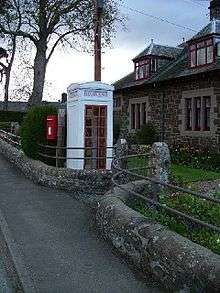 The only K3 Mk2 kiosk still in use, near Rhynd in Perth and Kinross, Scotland
The only K3 Mk2 kiosk still in use, near Rhynd in Perth and Kinross, Scotland K4 Post Office in Warrington – the vertical panels either side of the letter-slot originally housed stamp vending machines
K4 Post Office in Warrington – the vertical panels either side of the letter-slot originally housed stamp vending machines- K6 in Goathland, North Yorkshire
 Decommissioned K6 box in Newbold Pacey, Warwickshire
Decommissioned K6 box in Newbold Pacey, Warwickshire Decommissioned K6 boxes in Preston, Lancashire
Decommissioned K6 boxes in Preston, Lancashire K6 kiosks, illuminated at night
K6 kiosks, illuminated at night A green K6 box near Stokesley in North Yorkshire
A green K6 box near Stokesley in North Yorkshire- KX100 in Hapsford, Cheshire
- Non-GPO/BT kiosks in the United Kingdom
- Preserved Kingston-upon-Hull crown-less K6 in original Hull Corporation livery in Hull Transport Museum
.jpg) Kingston Communications K6 in Hull
Kingston Communications K6 in Hull K8 housing an internal telephone at Golders Green tube station
K8 housing an internal telephone at Golders Green tube station Kingston Communications KX100 PLUS in Hull
Kingston Communications KX100 PLUS in Hull- Two black K6 telephone boxes in Piccadilly in the City of Westminster, operated by New World Payphones Ltd
- British telephone kiosks abroad
 A K2 box at the Gibraltar Botanic Gardens
A K2 box at the Gibraltar Botanic Gardens K6s in St. John's, Antigua
K6s in St. John's, Antigua- K6 in Valletta, Malta
- Crown-less K6s in the Troodos Mountains in Cyprus
 K6 in Petah Tikva, Israel
K6 in Petah Tikva, Israel Queens crown K6 at Fifth Street Public Market in Eugene, Oregon
Queens crown K6 at Fifth Street Public Market in Eugene, Oregon University of Oklahoma - red K6 in front of Copeland Hall.
University of Oklahoma - red K6 in front of Copeland Hall. A replica of a K6 in a British themed shop window in Hong Kong
A replica of a K6 in a British themed shop window in Hong Kong- A K6 box at the Église Saint-Jean-Baptiste in Percy, Manche in Normandy, France
 Two imitation British red telephone boxes at Brussels-South railway station
Two imitation British red telephone boxes at Brussels-South railway station.jpg) British red phone box alongside standard Bell Canada boxes at former Kingston and Pembroke Railway station
British red phone box alongside standard Bell Canada boxes at former Kingston and Pembroke Railway station

See also
- Pillar box (red UK postal box)
- Police box (blue UK police phone box)
- AEC Routemaster (red London bus)
- KX telephone boxes
- "Red Frame/White Light" (OMD song)
References
- Odone, Cristina (11 March 2013). "The trashing of the iconic red phone box is one bad call". The Daily Telegraph.
- "Long list unveiled for national vote on public's favourite example of Great British Design". BBC. 18 November 2016.
- "Concorde voted the UK's top icon". BBC News. 18 November 2016.
- "Search Results for K1 TELEPHONE KIOSK". Historic England. Retrieved 10 May 2020.
- Historic England. "K1 Telephone Kiosk in Market Hall (Grade II) (1219597)". National Heritage List for England. Retrieved 22 November 2017.
- Historic England. "K1 Telephone Kiosk located outside the options [sic] (Grade II) (1365354)". National Heritage List for England. Retrieved 22 November 2017. The kiosk is in fact outside the former optician's, now Captain Stan's Fish Shop, 5 High Street.
- New Telephone Kiosks", The Times, 28 March 1925, p. 9
- Kennedy, Maev (23 November 2015). "Sir John Soane: how tomb for architects wife inspired the red telephone box". The Guardian. Retrieved 27 October 2017.
- Stamp 1989, p. 13.
- Johannesesn 1999, p. 7.
- Stamp 1989, pp. 13–14.
- Stamp 1989, p. 14.
- Stamp 1989, pp. 14–15.
- "Series 1, Episode 4". I Never Knew That About Britain. Season 1. Episode 4. 24 March 2014. ITV. Archived from the original on 15 April 2014. Retrieved 14 April 2014.
- "Remember When UK – restoration – GPO trailer restoration". Redtelephonebox.com.
- "1959-K7's". henderson-tele.com. Retrieved 31 March 2018.
- UniTech. "Connected Earth: Telephone kiosks". www.connected-earth.com. Retrieved 31 March 2018.
- "A pictorial guide to telephone boxes..." redphonebox.info.
- Willis, David K (25 February 1981). "Britain hangs on to tradition with a stiff upper lip". The Christian Science Monitor. Boston, Mass., USA: The First Church of Christ, Scientist. Retrieved 20 April 2014.
- "Telephone Service West Country London (1981)". House of Lords. Historic Hansard. 11 February 1981. Retrieved 20 April 2014.
- "1981 Feb 10 Tu – Margaret Thatcher – House of Commons PQs". margaretthatcher.org. Margaret Thatcher Foundation. Retrieved 20 April 2014.
- "KIOSKS – KX TYPES". britishtelephones.com.
- Wright, Patrick (1991), A Journey Through Ruins: The Last Days of London, OUP Oxford, ISBN 978-0199541942 (p. 276)
- Lightfoot, Liz (6 November 2000). "Number's up for phone box sculpture". The Daily Telegraph. London. Retrieved 23 May 2019.
- Coltman, Richard. "The Telephone Box". www.the-telephone-box.co.uk. Retrieved 20 January 2020.
- https://www.inlinkuk.com/
- Adopt a Kiosk, British Telecom
- "Adopt a Kiosk | BT.com". Payphones.bt.com. 12 April 2011. Retrieved 29 November 2013.
- "Is the pay phone making a comeback? - CNN.com". Edition.cnn.com. 20 December 2012. Retrieved 30 November 2013.
- Morris, Steven (30 November 2009). "Ringing the changes: phone box becomes mini-library". The Guardian. London. Retrieved 1 December 2009.
- "Phone box has new life as library". BBC. 29 November 2009. Retrieved 1 December 2009.
- "Phone box's new calling". This is Somerset. 16 November 2009. Archived from the original on 13 December 2009. Retrieved 1 December 2009.
- "Is this the tiniest library in Cheshire?". Cheshire Life. 10 September 2013. Retrieved 14 June 2014.
- "Telephone box libraries – a gazetteer". Association of Independent Libraries. 8 November 2013. Retrieved 13 June 2014.
- "Twin town's gift keeps on giving". www.cumbernauld-news.co.uk. Retrieved 15 December 2017.
- "3,000th adopted red phone box fitted with defibrillator to help save lives". bt.com. Retrieved 31 March 2018.
- "Convert a BT Kiosk - Community Heartbeat Trust". www.communityheartbeat.org.uk. Retrieved 31 March 2018.
- "Life-saving device is installed in Witney". Oxford Mail. 23 April 2018.
- "Brookwood phone box restored by residents". getsurrey.co.uk. 10 March 2010.
- Brookwood K6 Red Telephone Box Preservation, 15 October 2011
- Insley, Jill (26 April 2012). "BT sells off phone boxes as demand declines". The Guardian. Retrieved 31 January 2014.
- Rainey, Sarah (9 May 2012). "Inside the red phone box graveyard". The Daily Telegraph. Retrieved 31 January 2014.
- Kay, Thornton (8 August 2012). "BT's old red telephone boxes, kiosks (or booths) to be sold off". SalvoNews. Retrieved 31 January 2014.
- "Phone boxes turn green to charge mobiles". BBC News. 2 October 2014.
- "The Village Shops". The Village Shops. Retrieved 29 November 2013.
- "Johansson's Dining House • History". Johanssonsdininghouse.com.
- "The Telephone Box War - Wizard of New Zealand". archive.org. 1 February 2004. Archived from the original on 1 February 2004. Retrieved 31 March 2018.CS1 maint: BOT: original-url status unknown (link)
- "Phone Box in Porto | Photo". Travelblog.org. 28 March 2011.
- Chinon (1 January 1970). "chinon – Google Maps". Goo.gl. Retrieved 29 November 2013.
- Sennett, Richard (2019). Construir y habitar: ética para la ciudad (in Spanish) (1st ed.). Barcelona: Anagrama. p. 151. ISBN 978-84-339-6433-5.
- "Britain's classic red telephone boxes get a makeover". CNN. 21 June 2017.
- "Dial T for telephone: an A-Z of phones on film". BFI. Retrieved 21 June 2017
- "Gordon Ramsay's fourth Las Vegas Strip eatery: a fish-and-chips shop". Los Angeles Times. Retrieved 23 March 2019.
- alisonscolumn (20 January 2013). "Lifesigns: the first wave in the new British prog tsunami". Progarchy. Retrieved 9 May 2020.
- "Lifesigns - Live In London - Under The Bridge". Discogs. Retrieved 9 May 2020.
Bibliography
- Stamp, Gavin (1989). Telephone Boxes. London: Chatto & Windus. ISBN 0-7011-3366-X.
- Johannessen, Neil, ed. (1991). Ring up Britain: the early years of the telephone in the United Kingdom. London: British Telecom. ISBN 0948257881.
- Johannessen, Neil (1999). Telephone Boxes (2nd ed.). Princes Risborough: Shire. ISBN 0-7478-0419-2.
External links
| Wikimedia Commons has media related to Red telephone boxes. |
- The Telephone Box Complete illustrated history of the Red Telephone Box. Includes K5 & K7 images.
- PayPhoneBox Index of British Red Phone Boxes.
- More K6 facts
- Red telephone kiosks in Oxford, England
- Red phone boxes in the Welsh landscape
- Existing red phone boxes around the city of Liverpool
- Where I Live: Are there any K8's out there? (BBC)
